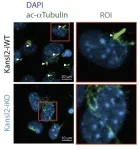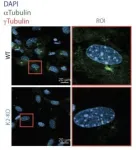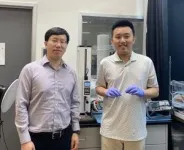(Press-News.org) Cilia are thin, eyelash-like extensions on the surface of cells. They perform a wide variety of functions, acting as mechanosensors or chemosensors, and play a crucial role in many signaling pathways. In the last few decades, the organelle has undergone a remarkable, but at the same time sinister, career transformation. It evolved from an organelle whose relevance was unclear to becoming a central player in the pathogenesis of a large group of diseases. These so-called ciliopathies are associated with a wide range of symptoms, including hearing loss, visual impairment, obesity, kidney disease, and mental disability. Different gene mutations impair cilia formation, maintenance, and function, resulting in these ciliopathies, which can sometimes be multi-organ, syndromic disorders.
The proper assembly, maintenance, and function of cilia rely on a process called “intraciliary transport”. Components of the intraciliary transport system “walk” on the microtubule to deliver cargo between the cell body and the ciliary tip to ensure a constant supply of materials. Mutation of genes encoding components within the intraciliary transport machinery could lead to ciliopathies. In their recent study in the journal Science Advances, the lab of Asifa Akhtar identified the NSL complex as a transcriptional regulator of genes known for their roles in the intraciliary transport system of cilia across multiple cell types.
The NSL complex enables intraciliary transport
The NSL complex is a potent epigenetic modifier that regulates thousands of genes in fruit flies, mice, and humans. However, most of the functions of the NSL complex remain mysterious and have only recently begun to be elucidated. “Previous research from our lab indicates that the NSL complex controls many pathways critical for organismal development and cellular homeostasis,” says Asifa Akhtar, Director at the MPI of Immunobiology and Epigenetics in Freiburg.
The complex comprises several proteins and is a histone acetyltransferase (HAT) complex that prepares the genes for activation. “Think of gene regulation as a team effort with different players. One important player is the NSL complex. It puts special marks on the histone proteins on which the DNA is wrapped around in the nucleus, like putting up green flags. These flags tell other regulators to switch on specific genes. We now found that the NSL complex does exactly this for a group of genes linked to moving materials within cilia,” says Tsz Hong Tsang, the first author of the study.
Without components of the NSL complex, the cell cannot build a cilium
The intraciliary transport system is essential because it is needed to build a functional cilium. The cell uses the intraciliary transport system to move material from the cilium base to the growing tip – similar to building a tower. In the study, the researchers used mouse cells to determine the functional consequences of the loss of the NSL complex in the cells.
They found that fibroblast cells lacking the NSL complex protein KANSL2 could not activate the transport genes nor assemble cilia. “As cilia are the sensory and signaling hubs for cells, loss of KANSL2 leads to the inability of cells to activate the sonic hedgehog signaling pathway, which plays important roles in the regulation of embryonic development, cell differentiation, and maintenance of adult tissues as well as cancer,” says Asifa Akhtar.
Although tiny protrusions, these sensory organelles are incredibly important to cells. Ciliopathies, which affect organs as diverse as the kidney, liver, eye, ear, and central nervous system, remain challenging for biological and clinical studies. The researchers at the Max Planck Institute in Freiburg hope that their analysis of the role of the NSL complex has provided important insights into the regulation of these organelles and the genes associated with them, thus contributing to human health.
Consequences of NSL loss in non-ciliated cells
Cilia are found in most cell types in the human body. This explains why ciliopathies can affect so many different organs and tissues, but there are also cells that are not ciliated. One of the cell types that do not have cilia is mature glomerular podocytes, which are special filtration cells in the kidney. “Interestingly, we found that podocytes also express these intraciliary transport genes that are regulated by the NSL complex. So, we wondered what would happen if they are unable to switch on these genes,” says Tsz Hong Tsang.
The researchers found that in non-ciliated mouse podocytes, the loss of KANSL2 leads to changes in microtubule dynamics in the cells. Microtubules are cytoskeletal components responsible for the mechanical stabilization of the cell and intracellular transport between different organelles. While lacking cilia, mature podocytes have specialized cell processes extending from the cell body called primary and secondary processes, whose functions rely heavily on cytoskeletal components. Although apparently milder than the defect in ciliated cells, the Akhtar lab found that the cytoskeletal defects are likely the cause of severe glomerulopathy and kidney failure observed in mice lacking the NSL complex. These and other extraciliary functions of intraciliary transport genes may help explain the complexity of symptoms presented by ciliopathies.
END
Unlocking the secrets of cell antennas
The NSL complex is a key player in controlling intraciliary transport genes
2023-08-25
ELSE PRESS RELEASES FROM THIS DATE:
How origami might inform disease diagnoses
2023-08-25
Researchers at the USC Viterbi School of Engineering looked to origami to create new sensors that could someday be employed to detect deformations in organs and also for use in wearables and soft robotics.
Their paper, “High-Stretchability and Low-Hysteresis Strain Sensors Using Origami-Inspired 3D Mesostructures,” featured in Science Advances explains how USC researchers Hangbo Zhao, Xinghao Huang, Liangshu Liu, Yung Hsin Lin, Rui Feng, Yiyang Shen, and Yuanning Chang developed “stretchable strain sensors,” ...
Weight loss medication benefits patients with heart failure and obesity
2023-08-25
Amsterdam, Netherlands – 25 Aug 2023: Semaglutide improves heart failure-related symptoms and physical function and results in greater weight loss compared with placebo in patients with heart failure with preserved ejection fraction (HFpEF) and obesity, according to late breaking research presented in a Hot Line session today at ESC Congress 2023.1
Approximately half of patients with heart failure in the community have HFpEF.2 Most patients with HFpEF are overweight or obese, and growing evidence suggests that obesity and excess adiposity are not simply comorbidities, ...
Oral anticoagulation is not effective in patients with atrial high-rate episodes
2023-08-25
Amsterdam, Netherlands – 25 Aug 2023: Blood thinners (anticoagulants) cause bleeding without preventing stroke in patients with atrial high rate episodes (AHRE), but without electrocardiogram (ECG)-diagnosed atrial fibrillation, according to late breaking research presented in a Hot Line session today at ESC Congress 2023 and simultaneously published in the New England Journal of Medicine.1
Anticoagulants prevent strokes in patients with atrial fibrillation but are not effective in those without atrial fibrillation, for example in patients with ...
Colchicine fails to reduce primary outcomes in COP-AF trial but encouraging signals found
2023-08-25
Amsterdam, Netherlands – 25 Aug 2023: Colchicine does not significantly reduce perioperative atrial fibrillation (AF) or myocardial injury after non-cardiac surgery (MINS) in patients undergoing major non-cardiac thoracic surgery, according to late breaking research presented in a Hot Line session today at ESC Congress 2023.1
Perioperative AF occurs in approximately 10% of patients after major thoracic surgery, while MINS has an incidence of about 20% in the same patient population.2 Patients with perioperative AF and MINS have a poor prognosis.3,4 High levels ...
First ESC Guidelines covering all acute coronary syndromes published today
2023-08-25
Amsterdam, Netherlands – 25 Aug 2023: The European Society of Cardiology (ESC) Guidelines on acute coronary syndromes are published online today in European Heart Journal.1 The document covers the management of unstable angina and all types of acute myocardial infarction.
“Time is critical in acute coronary syndromes. When an artery supplying the heart with blood becomes blocked, the quicker we open the artery and restore flow, the less damage occurs to the heart muscle,” said Guidelines task force ...
First international guidelines on heart muscle diseases published today
2023-08-25
Amsterdam, Netherlands – 25 Aug 2023: The European Society of Cardiology (ESC) Guidelines on cardiomyopathies are published online today in European Heart Journal.1 This is the first international guideline document to include all cardiomyopathy subtypes, and the first time that specific recommendations are made for cardiomyopathies other than hypertrophic cardiomyopathy.
“This pioneering document reflects the advances in genetics and cardiac imaging and the advent of new treatments that target specific causes of disease,” said Guidelines task force chairperson Dr. Elena Arbelo of the Hospital Clinic, University of Barcelona, Spain.
“At the ...
Recommendations to reduce cardiovascular risk in patients with diabetes published today
2023-08-25
Amsterdam, Netherlands – 25 Aug 2023: Patients with type 2 diabetes are more than twice as likely to develop cardiovascular disease (CVD) than their healthy peers. Advice to lower that risk is launched today in the 2023 European Society of Cardiology (ESC) Guidelines for the management of cardiovascular disease in patients with diabetes, published in European Heart Journal.1
“Patients with type 2 diabetes have a two- to four-fold higher risk of coronary artery disease, stroke, heart failure, atrial fibrillation and peripheral artery disease compared to those without type 2 diabetes and when CVD occurs, the prognosis ...
Patients urged to be vigilant about cardiac infections
2023-08-25
Amsterdam, Netherlands – 25 Aug 2023: Patients with specific cardiac conditions such as valvular heart disease and congenital abnormalities, or those requiring a pacemaker, should practice good dental and skin hygiene to help prevent rare but potentially deadly infections of the heart’s inner lining and valves, according to European Society of Cardiology (ESC) Guidelines on infective endocarditis, published online today in European Heart Journal.1
“Infective endocarditis is an uncommon but very serious disease that can present with ...
Focused update of ESC Heart Failure Guidelines published today
2023-08-25
Amsterdam, Netherlands – 25 Aug 2023: A focused update of the European Society of Cardiology (ESC) Heart Failure Guidelines is published online today in European Heart Journal following the results of major new trials that should change the management of patients with heart failure.1
“Heart failure is a fast-moving area of research and exciting new trials are expanding the treatment options for patients,” said Guidelines task force chairperson Professor Theresa McDonagh of King’s College Hospital, London, UK. “This focused update incorporates the latest evidence-based treatments ...
Cancer drug development yesterday, today and tomorrow
2023-08-25
“One can expect that artificial intelligence (AI) will play some role in the future drug development.”
BUFFALO, NY- August 25, 2023 – A new editorial paper was published in Oncoscience (Volume 10) on August 17, 2023, entitled, “Cancer drug development yesterday, today and tomorrow.” In this new editorial, researchers Elzbieta Izbicka and Robert T. Streeper from New Frontier Labs discuss the history of cancer drug development and how it has evolved over time. The editorial also highlights the current state of cancer drug development and ...
LAST 30 PRESS RELEASES:
When is it time to jump? The boiling frog problem of AI use in physics education
Twitter data reveals partisan divide in understanding why pollen season's getting worse
AI is quick but risky for updating old software
Revolutionizing biosecurity: new multi-omics framework to transform invasive species management
From ancient herb to modern medicine: new review unveils the multi-targeted healing potential of Borago officinalis
Building a global scientific community: Biological Diversity Journal announces dual recruitment of Editorial Board and Youth Editorial Board members
Microbes that break down antibiotics help protect ecosystems under drug pollution
Smart biochar that remembers pollutants offers a new way to clean water and recycle biomass
Rice genes matter more than domestication in shaping plant microbiomes
Ticking time bomb: Some farmers report as many as 70 tick encounters over a 6-month period
Turning garden and crop waste into plastics
Scientists discover ‘platypus galaxies’ in the early universe
Seeing thyroid cancer in a new light: when AI meets label-free imaging in the operating room
Neutrophil-to-lymphocyte ratio may aid risk stratification in depressive disorder
2026 Seismological Society of America Annual Meeting
AI-powered ECG analysis offers promising path for early detection of chronic obstructive pulmonary disease, says Mount Sinai researchers
GIMM uncovers flaws in lab-grown heart cells and paves the way for improved treatments
Cracking the evolutionary code of sleep
Medications could help the aging brain cope with surgery, memory impairment
Back pain linked to worse sleep years later in men over 65, according to study
CDC urges ‘shared decision-making’ on some childhood vaccines; many unclear about what that means
New research finds that an ‘equal treatment’ approach to economic opportunity advertising can backfire
Researchers create shape-shifting, self-navigating microparticles
Science army mobilizes to map US soil microbiome
Researchers develop new tools to turn grain crops into biosensors
Do supervised consumption sites bring increased crime? Study suggests that’s a myth
New mass spec innovation could transform research
Maternal nativity, race, and ethnicity and infant mortality in the US
Migration-related trauma among asylum seekers exposed to the migrant protection protocols
Jupiter’s moon Europa has a seafloor that may be quiet and lifeless
[Press-News.org] Unlocking the secrets of cell antennasThe NSL complex is a key player in controlling intraciliary transport genes




